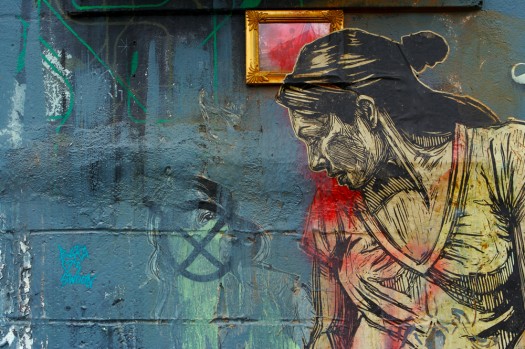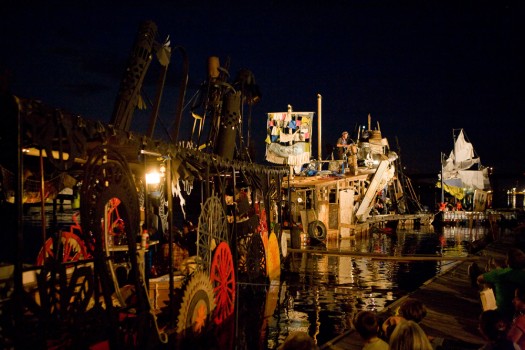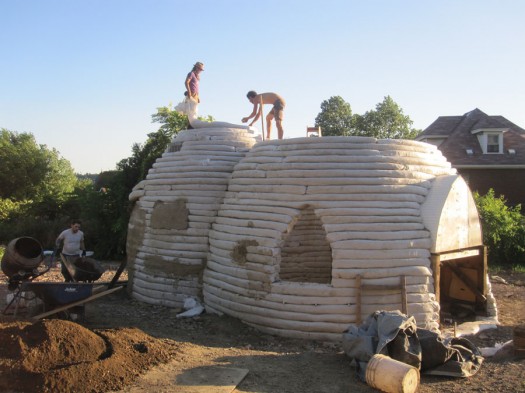
We are celebrating 15 years — and counting — of stories that are deeply researched and deeply felt, that build a historical record of what the city has been.
We are celebrating 15 years — and counting — of stories that are deeply researched and deeply felt, that build a historical record of what the city has been.
This is the fourth in our series of interviews with artists represented by Christina Ray — a gallery and creative catalyst dedicated to contemporary artwork that explores the relationship between people and places. We have previously heard from Roberto Mollá, who explores the cityscape through architectural representation, woodblock prints, anime and modernist graphic design, Emily Henretta, who draws on chaos and order, construction and destruction, renovation and decay to contemplate the idea of cities, and Heather L. Johnson, who takes inspiration from complex infrastructure systems and their impact on the physical space and experience of urban environments.
Swoon, a Brooklyn-based artist, has worked in a variety of media to engage constructed environments. She has used the city as canvas for her cut-paper woodblock prints, often seen wheatpasted on city streets. Since 2006, she has used cityscapes as inspiration as she designed, built and sailed on raft flotillas created as intentional communities of artists and musicians. Now she can be found in Haiti co-running the Konbit Shelter Project, a group of artists, builders, architects and engineers who are using their skills and resources to build homes and community spaces in post-earthquake Haiti. Read our conversation with Swoon below. To inquire about availability of Swoon’s work, contact Christina Ray.

Photo by Flickr user niznoz.
Let’s start with the city street and the relationship between the conditions of inspiration, production and display. What is the difference to you between creating for a canvas versus for a city wall? Does the distinction change the audience, the message, or both?
Almost the only difference for me in creating for a protected indoor setting versus creating for outside is a practical one. Things have to be smaller and faster to put up outside, more streamlined in their design. If I am cutting paper to create a portrait, and I find myself making really large cuts, I know it’s going to be a lot harder to paste up quickly. Or, if I am making something huge, I know that it will have trouble finding itself within the small architectural niches of a more dense urban area. Because my way of working and creating portraits evolved entirely in dialogue with city walls, these practical considerations, as well as thoughts about how people relate to the portraits when they see them on the street, are a big part of forming what you see, whether I am making a gallery installation, or working on the street. The creative process is very quiet compared to the execution and the life of the piece. And the conditions of inspiration? That’s just day to day.

Swimming Cities of Switchback Sea. Photo © Tod Seelie/todseelie.com.
Since 2006, you have designed, built and traveled on fleets of rafts and vessels manned by a community of artists. Your initial motivations were threefold: to create, to interact with others, and to explore. What is the role of place or site in these intentional communities? How does the social element relate to the spatial?
I wanted to understand the city more and more — from how people live within it and interact with it, to how it is created, built, broken and rebuilt.Over the first two years, the rafts were intentional communities. The Miss Rockaway Armada was a collectively built and run, floating, intentional community. We made all of our decisions together. We were an experiment for ourselves as well as a public facing one — traveling down the river and talking to everyone we saw.
The Switchback and the Serenissima projects were a blurrier line between art and life. I measured the bridges on the Grand Canal in Venice to the inch at low tide before building the three boats that traveled there. They were made as a kind of an homage to that place — little, monstrous, fantastical, floating bits of city. I envisioned them like seeds, blown far from the mother tree, having evolved in their own way, somehow finding their outgrowths back in their land of origin. The first time I saw Venice rising up out of the sea like it does, I was so affected that I knew one day I would make something that let me understand that place better, and that was a response to it. There was also a whole undercurrent of thought about rising tides, and being refugees from a society that is no longer functioning with relation to the planet’s ability to sustain it. The very fluid community that formed around these projects is a part of a larger community of artists that already exists, and are the only thing that made such a project possible.
What do you see as the role of the artist in the kind of recovery work you are undertaking in Haiti? How does this project relate to other aspects of your work — or do you see it as something entirely distinct from your artistic oeuvre?
I guess I view the role of artists like myself and the Konbit group who are here in Haiti right now in two ways. First, we hope to acknowledge that beauty and soulfulness are important in the rebuilding effort, as well as the nitty gritty work of getting roofs over people’s heads. We also are in the unusual position of operating independently. As a small, self-directed group, we have a fluidity that many large NGOs don’t have. There are so many levels to this process, I think a plethora of responses are welcome and needed.
How this relates to the rest of my life and work I think is yet to be seen.

Konbit shelter prototype build, Braddock, PA. Via konbitshelter.org.
From your wheatpaste street art to Swimming Cities to your current work in Haiti, your work has flowed between the use of the built form and cities as canvas or inspiration to the actual construction of livable spaces. How has each body of work influenced or informed the others?
Snowball effect? I started by drawing it, and found that I wanted to understand the city more and more — from how people live within it and interact with it, to how it is created, built, broken, and rebuilt. The question of how so many people will survive on a planet that clearly cannot support them all is very central in my mind, as well as the role that cities, architecture and living systems have in that. Right now I am trying to understand more intimately how it is that we might all live and survive here — and to try and help in very small but concretely tangible ways while I am learning.
Regarding the Konbit shelters: Why did you choose this particular method of construction and design? What climate, community or resource considerations led you to decide on superadobe structures?
After the earthquake, I became really obsessed with the dome. I think this is a common condition that sometimes strikes people. It’s one of the most perfect structures. It handles forces so beautifully, both within the structure, and without — from distributing a force evenly throughout the whole structure to deflecting wind and water via the curvature of its walls. Researching further into variations on domes as living structures, I found the work of Nader Khalili. Khalili dedicated the later part of his life to developing earthquake, hurricane, fire, and flood resistant housing for the world’s poor using a minimum of materials — mainly dirt. He developed workable systems and left the use of them free of patents for humanitarian aid. Ben Wolf and I knew we wanted to work on a building project to help out after the quake, and it made a lot of sense to learn about an existing developed system, rather than try to reinvent the wheel, and to share it with people who could find it useful.
We’re here building now — and so far so good. We are using the dirt that we dug out of the foundation to build with and, though building materials are pretty horribly expensive here, it’s working. We are building first a community center/hurricane shelter, and hope to return in late fall/early winter to create some houses.
.
Interview conducted by Varick Shute.
The views expressed here are those of the authors only and do not reflect the position of The Architectural League of New York.